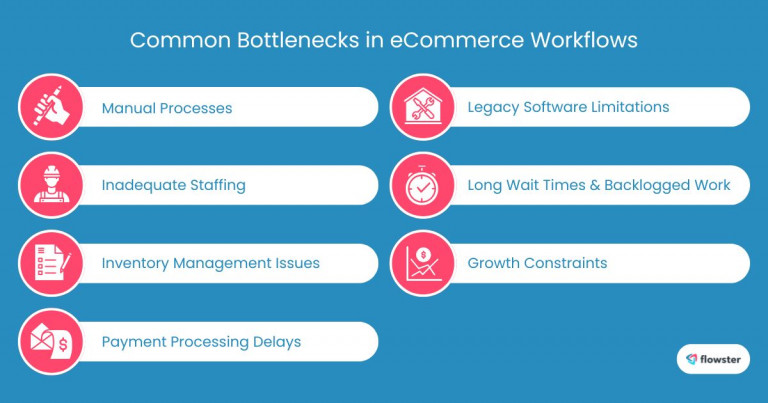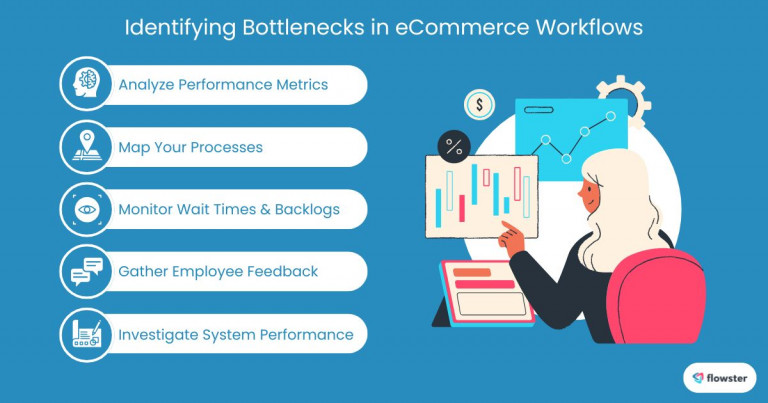In today’s fast-paced eCommerce landscape, efficiency is paramount. Smooth and seamless workflows are the backbone of successful online businesses. However, even the most well-oiled machines can encounter bottlenecks in eCommerce workflows. These bottlenecks can slow down operations, frustrate customers, and ultimately impact your bottom line.
By understanding the common culprits behind these workflow disruptions, you can take proactive steps to identify and eliminate them. In this article, we’ll delve into the most prevalent bottlenecks in eCommerce and explore actionable strategies to optimize your processes.
Article Outline
Understanding eCommerce Workflows
An eCommerce workflow is a series of interconnected steps that guide products or services from initial customer interaction to final delivery. It encompasses various processes, including order processing, inventory management, shipping, and customer service.
Key Components of eCommerce Workflows
- Order Processing: This involves receiving and processing customer orders, verifying product availability, and generating accurate invoices.
- Inventory Management: Efficient inventory management ensures that products are always in stock to meet customer demand. It also involves tracking stock levels, managing returns, and preventing stockouts.
- Shipping and Fulfillment: This component focuses on packaging, labeling, and shipping products to customers. It also involves tracking shipments and handling returns.
- Customer Service: Excellent customer service is essential for building customer loyalty. It includes responding to inquiries, resolving issues, and providing support throughout the customer journey.
Optimizing Workflows for Success
By optimizing your eCommerce workflows, you can improve efficiency, reduce costs, and enhance customer satisfaction. A well-structured workflow can help you scale your business, stay competitive, and deliver exceptional customer experiences.
In the next section, we’ll delve into the common bottlenecks in eCommerce workflows that can hinder your business’s growth.
Looking for a wider range of strategies to supercharge your eCommerce workflows? Explore this insightful article: 7 Proven Strategies to Supercharge eCommerce Workflows. Read now!
Capture Your Processes in Minutes!
Common Bottlenecks in eCommerce Workflows
Identifying and addressing bottlenecks in eCommerce workflows is crucial for maintaining operational efficiency and customer satisfaction. Let’s explore some of the most common bottlenecks that can hinder your eCommerce business.
Manual Processes
Manual tasks can significantly slow down your operations and increase the risk of errors. Common manual processes in eCommerce include:
- Manual order entry: This can be time-consuming and prone to human error.
- Manual inventory updates: Manual inventory tracking can lead to stockouts and overstock.
- Manual shipping label creation: This can delay shipping times and increase costs.
Inadequate Staffing
During peak seasons, understaffing can lead to longer processing times, delayed shipments, and poor customer service. This can result in:
- Increased order fulfillment times
- Higher rates of customer complaints and negative reviews
- Loss of revenue and customer loyalty
Inventory Management Issues
Inventory discrepancies and stockouts can disrupt your supply chain and negatively impact customer satisfaction. Common inventory management issues include:
- Inaccurate inventory counts
- Poor demand forecasting
- Inefficient inventory replenishment
Payment Processing Delays
Payment processing delays can lead to abandoned carts and lost sales. Common payment processing issues include:
- Declined payments due to insufficient funds or credit card issues
- Technical glitches in payment gateways
- Slow processing times
Legacy Software Limitations
Outdated software can hinder efficiency and limit your ability to scale. Common software limitations include:
- Lack of integration with other systems
- Poor performance and slow response times
- Limited scalability
Long Wait Times and Backlogged Work
Delays in approvals or information flow can create backlogs and slow down your operations. This can impact:
- Order processing times
- Customer response times
- Overall workflow efficiency
Growth Constraints
Inefficient workflows can limit your business’s ability to scale and grow. As your business expands, you may encounter challenges such as:
- Difficulty in managing increased order volume
- Inability to meet rising customer expectations
- Increased operational costs
By understanding these common bottlenecks, you can take proactive steps to identify and eliminate them. In the next section, we’ll discuss strategies for identifying bottlenecks in your eCommerce workflows.
To learn more about strategies to reduce cart abandonment caused by payment processing delays, you can check out this helpful article: Reduce Cart Abandonment with These Proven Strategies. Read now!

Strategies for Identifying Bottlenecks in eCommerce Workflows
To effectively address bottlenecks in eCommerce workflows, you must first identify where they exist. By implementing the following strategies, you can pinpoint areas of inefficiency and take corrective action.
Analyze Performance Metrics
Key Performance Indicators (KPIs) provide valuable insights into the efficiency of your workflows. By tracking metrics such as order processing time, shipping time, and customer response time, you can identify areas that require improvement.
Tools and Methods for Data Analysis:
- Business intelligence tools: These tools can help you visualize data and identify trends.
- Data analytics software: This software can be used to analyze large datasets and uncover hidden patterns.
Map Your Processes
Process mapping is a visual representation of your workflows. By mapping your processes, you can identify redundancies, bottlenecks, and areas for improvement.
Techniques for Conducting Workflow Audits:
- Swim lane diagrams: These diagrams can help you visualize the flow of work between different teams or departments.
- Process flowcharts: These diagrams can help you identify the specific steps involved in a process.
Monitor Wait Times and Backlogs
Tracking task completion times and identifying backlogs can help you pinpoint areas of inefficiency.
Tools for Monitoring Workflow Performance:
- Project management software: This software can be used to track task progress and identify delays.
- Workflow automation tools: These tools can help you automate repetitive tasks and reduce wait times.
Gather Employee Feedback
Your employees are on the front lines of your operations and can provide valuable insights into the challenges they face.
Strategies for Collecting Feedback Effectively:
- Surveys: Conduct regular surveys to gather feedback from your team.
- One-on-one meetings: Schedule regular one-on-one meetings with your team members to discuss their challenges and suggestions.
- Suggestion boxes: Encourage employees to submit ideas for improvement.
Investigate System Performance
Your technology infrastructure can significantly impact the efficiency of your workflows.
Techniques for Reviewing System Logs and Performance Metrics:
- System monitoring tools: These tools can help you track system performance and identify potential issues.
- Regular system maintenance: Keep your systems up-to-date with the latest patches and security updates.
By implementing these strategies, you can gain a clear understanding of your eCommerce workflows and identify the root causes of bottlenecks. In the next section, we’ll explore practical strategies for overcoming these bottlenecks.
While automation streamlines workflows, it can also directly impact sales. To explore how automation can specifically boost your eCommerce sales, check out this valuable resource: 5 Ways eCommerce Automation Can Boost Your Sales. Read now!

Overcoming Bottlenecks in eCommerce Workflows
Once you’ve identified the bottlenecks in eCommerce workflows hindering your operations, it’s time to take action. Here are some effective strategies to overcome these challenges:
Implement Automation Tools
- Reduce manual processes: Automate repetitive tasks like order processing, inventory updates, and shipping label generation.
- Improve efficiency: Automation can significantly reduce human error and increase productivity.
- Consider automation tools: Explore options like workflow automation software, robotic process automation (RPA), and AI-powered tools.
Optimize Staffing Levels
- Forecast demand: Analyze historical data to predict peak seasons and adjust staffing accordingly.
- Flexible staffing solutions: Consider using flexible staffing options like part-time workers or freelancers to accommodate fluctuating workloads.
- Cross-training: Train your staff on multiple tasks to improve flexibility and efficiency.
Enhance Inventory Management Practices
- Real-time inventory tracking: Implement a robust inventory management system to monitor stock levels in real-time.
- Accurate demand forecasting: Use data-driven insights to predict future demand and optimize inventory levels.
- Efficient order fulfillment: Streamline your order fulfillment process to minimize shipping times and reduce costs.
Streamline Payment Processing Systems
- Choose reliable payment gateways: Select payment gateways that offer fast and secure transactions.
- Optimize checkout process: Simplify your checkout process to reduce cart abandonment rates.
- Offer multiple payment options: Provide customers with a variety of payment options to cater to different preferences.
Upgrade Legacy Systems
- Invest in modern technology: Upgrade your outdated systems to improve performance and scalability.
- Integrate systems: Connect your systems to create a seamless workflow and reduce data entry errors.
- Cloud-based solutions: Consider cloud-based solutions for increased flexibility and accessibility.
Foster a Culture of Continuous Improvement
- Encourage employee feedback: Create a culture where employees feel empowered to share their ideas and suggestions.
- Regularly review processes: Conduct periodic reviews of your workflows to identify areas for improvement.
- Embrace change: Encourage your team to embrace new technologies and processes.
By implementing these strategies, you can overcome bottlenecks in eCommerce workflows and optimize your operations.
To delve deeper into the world of eCommerce process automation and explore specific tools, check out this informative article: eCommerce Process Management: Automate for Efficiency. Read now!
Flowster's AI-Driven Automation
Conclusion: Streamlining Your eCommerce Workflows for Success
By understanding and addressing bottlenecks in eCommerce workflows, you can significantly improve your operational efficiency, reduce costs, and enhance customer satisfaction. Remember, a well-optimized workflow is the foundation of a successful eCommerce business.
Take the first step towards streamlining your operations today. By analyzing your current processes, identifying bottlenecks, and implementing the strategies discussed in this article, you can unlock your business’s full potential.
Get Started with Free Workflow Templates
To help you get started on your workflow optimization journey, we offer a variety of free workflow templates on the Flowster Marketplace. These templates can be easily customized to fit your specific needs and help you streamline your processes.
In addition to free templates, Flowster also offers “Done-for-You” services, where our experts can create custom workflows tailored to your business requirements.
Don’t let bottlenecks hold your business back. Take control of your workflows and drive your eCommerce success.




